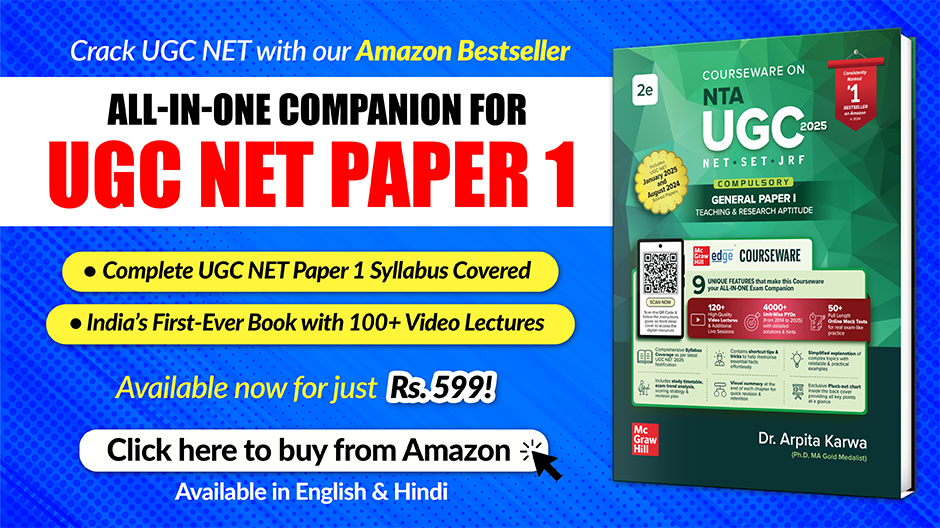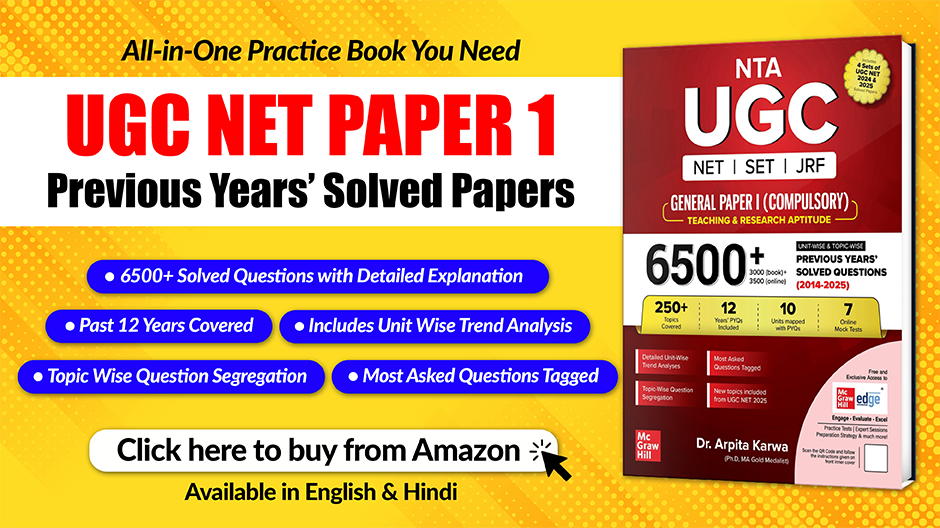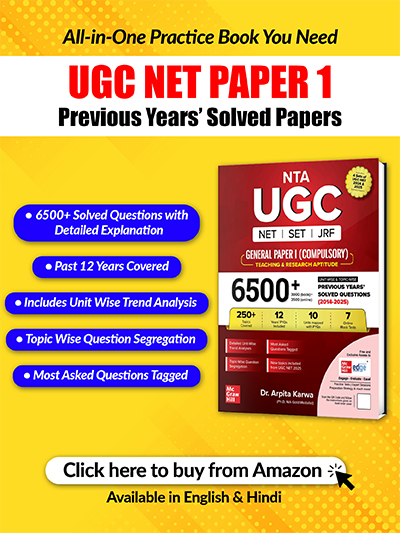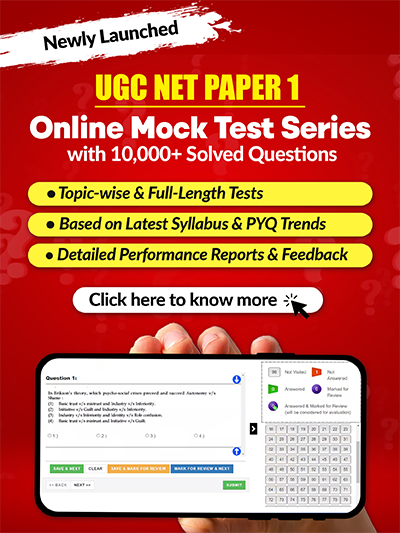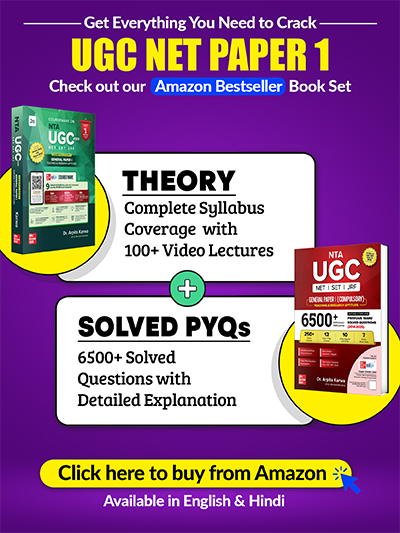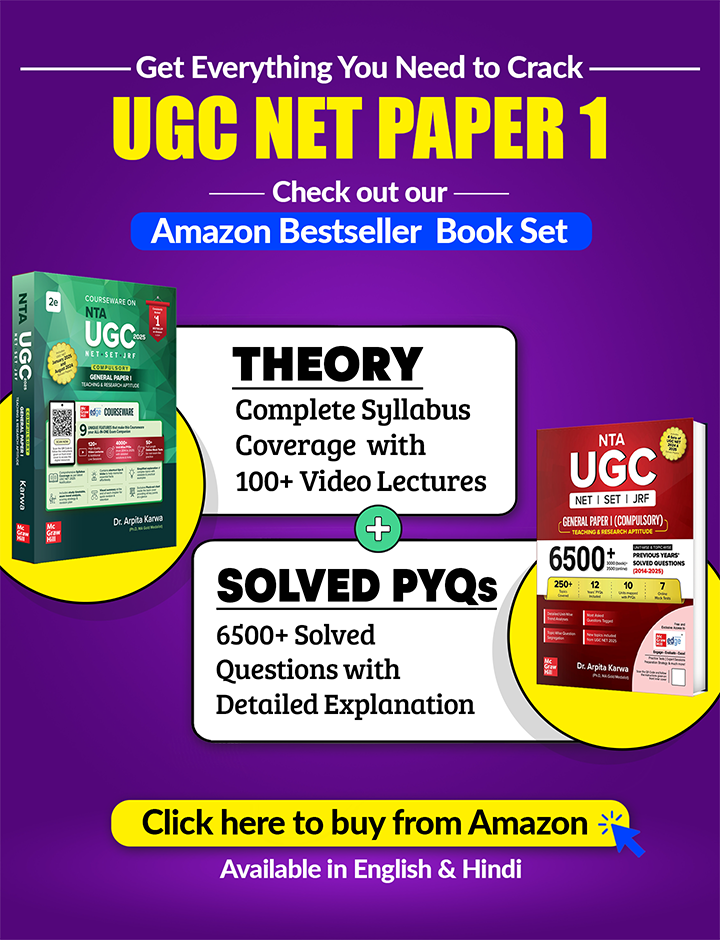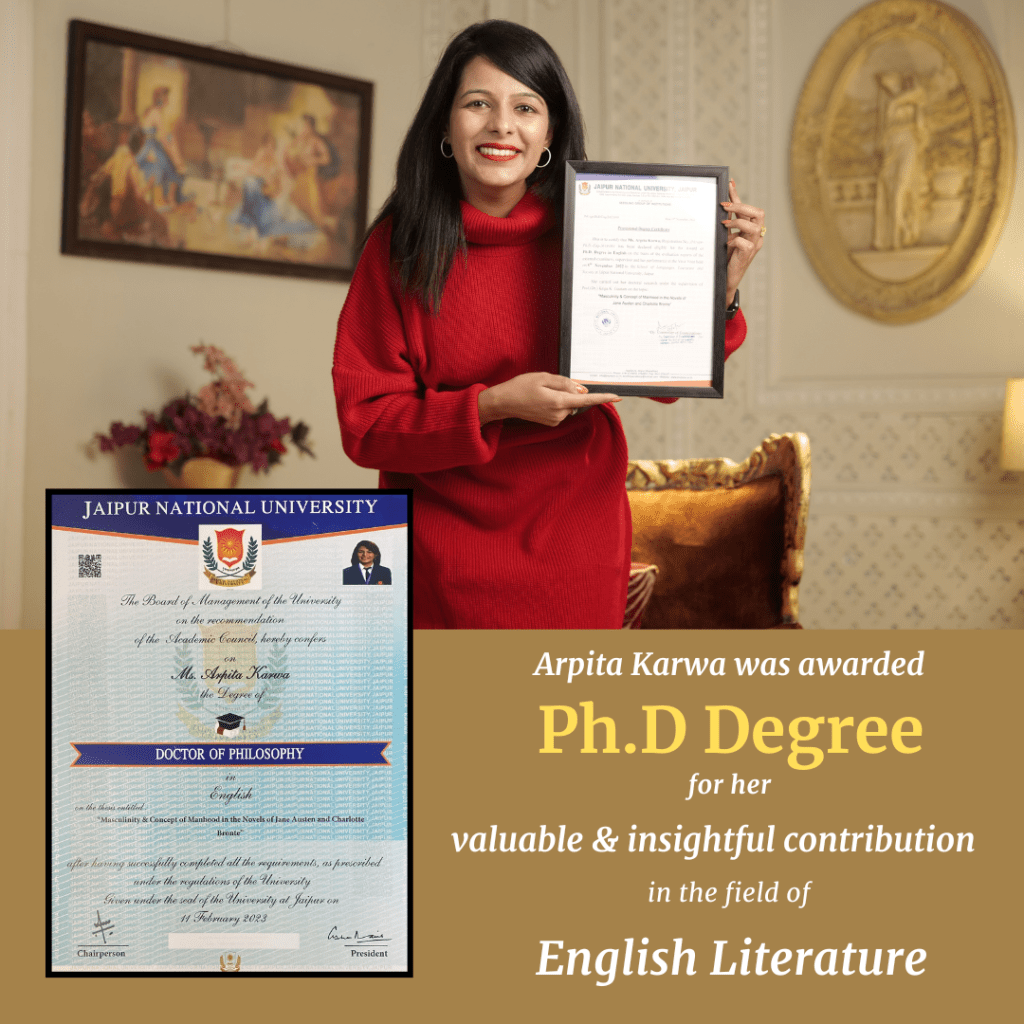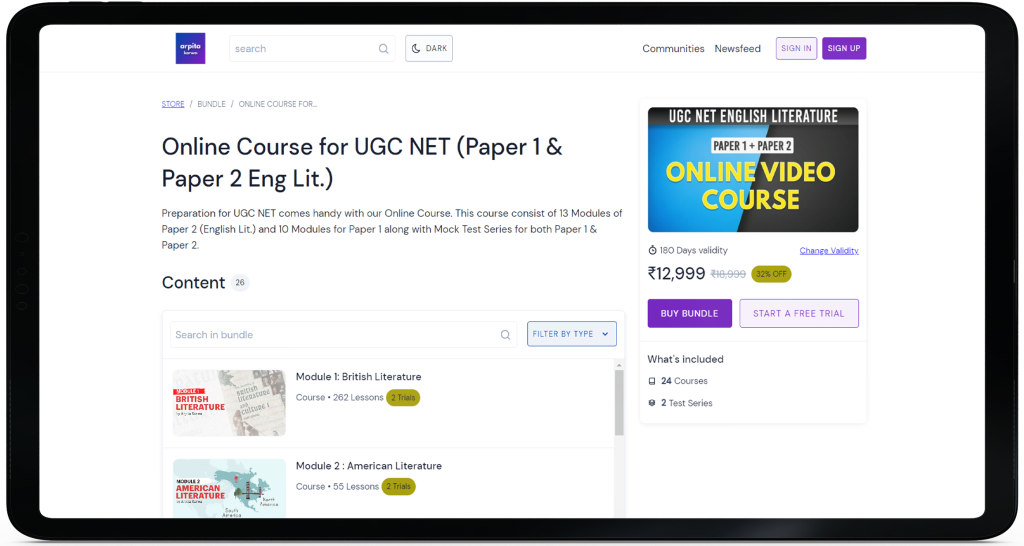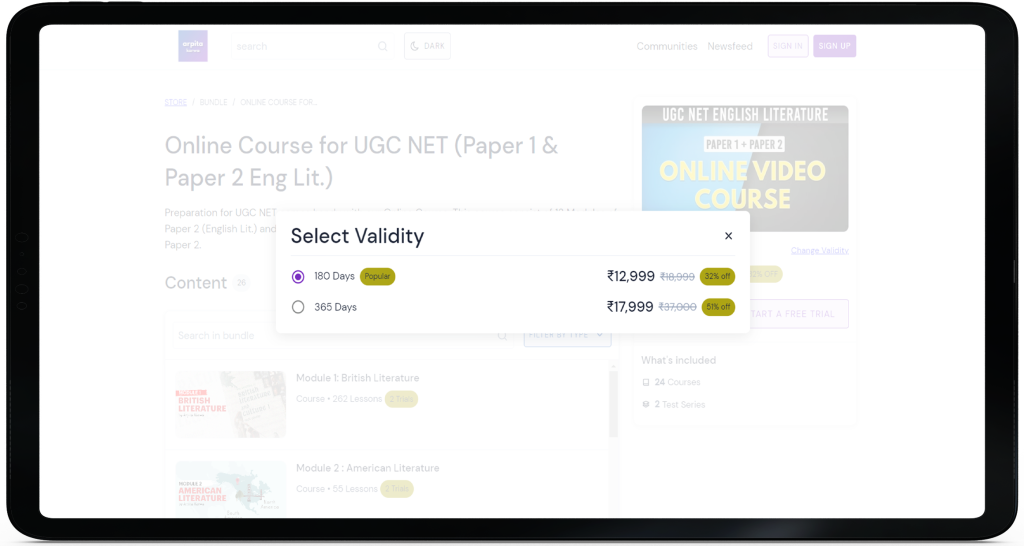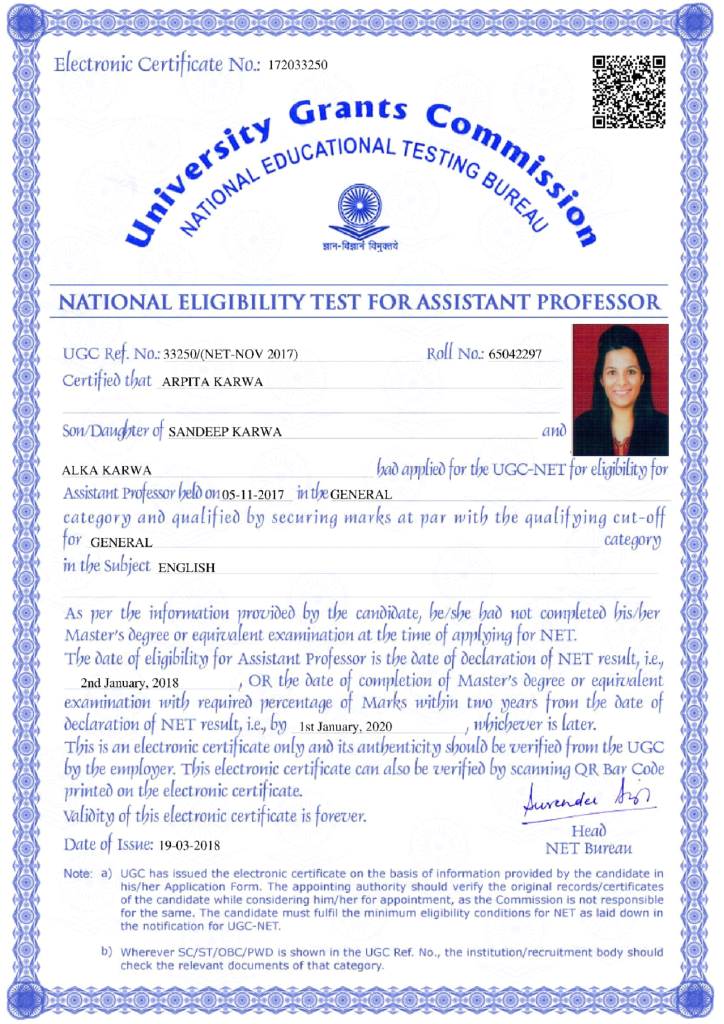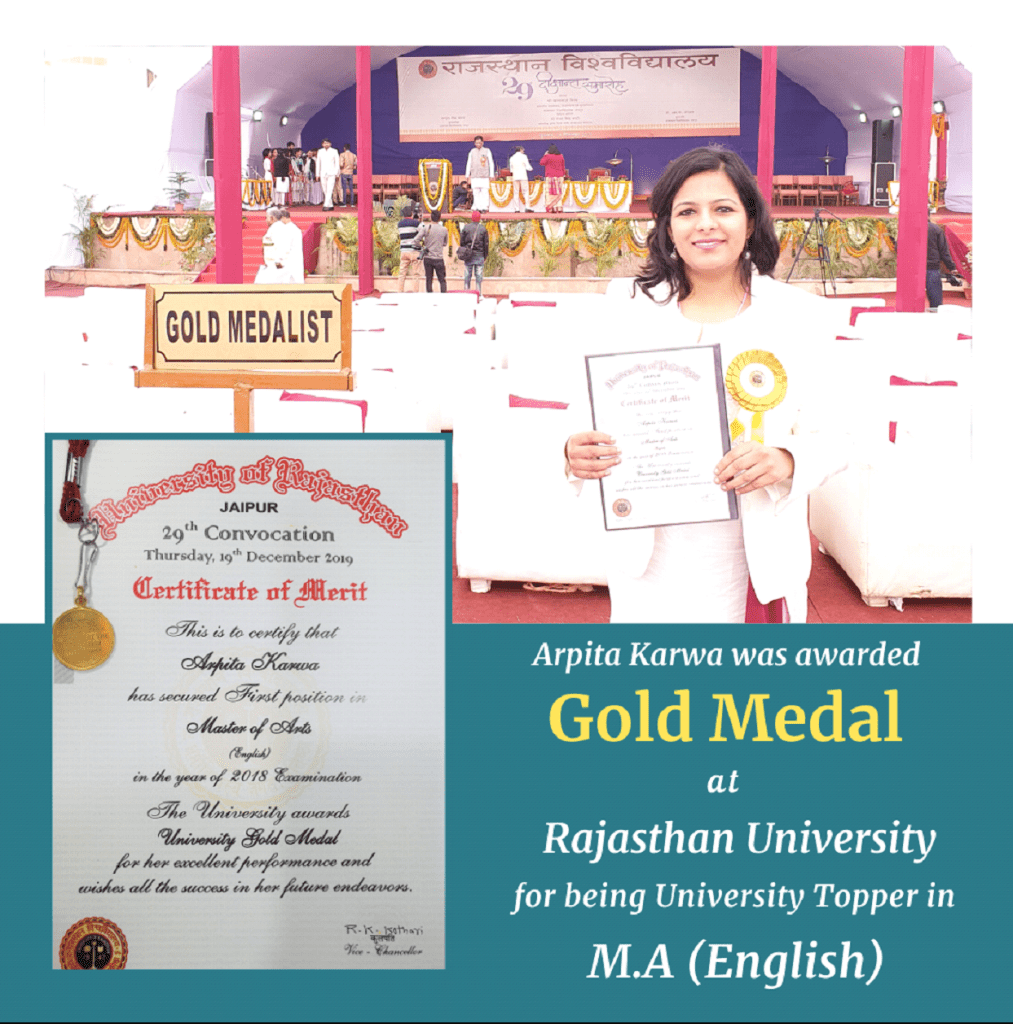UGC NET Paper 1 November 2020 (Conducted on 11th November 2020 : Evening Shift)
October 18, 2022 2025-08-18 14:15UGC NET Paper 1 November 2020 (Conducted on 11th November 2020 : Evening Shift)
November 2020: Paper 1 (Conducted on 11th Nov 2020 : Evening Shift)
Q.1-5)
Q.1) What is the respective ratio of the number of females in Mechanical Department to the number of females in Electronics Department?
[1] 4 : 3
[2] 23 : 22
[3] 24 : 21
[4] 23 : 21
Correct Answer: 2
Q.2) What is the total number of students in all the Departments?
[1] 2210
[2] 3210
[3] 3400
[4] 3310
Correct Answer: 4
Q.3) What is the total number of male students in Computer and Mining Department together?
[1] 266
[2] 886
[3] 786
[4] 686
Correct Answer: 3
Q.4) What is the ratio of the number of females in Civil and Electrical departments together to the number of males in the same Departments together?
[1] 311 : 270
[2] 320 : 261
[3] 411 : 469
[4] 311 : 269
Correct Answer: 4
Q.5) What is the average percentage of female students in the whole Institute?
[1] 42.0%
[2] 41%
[3] 43%
[4] 41.5%
Correct Answer: 1
Q.6) Which of the following teacher competency belongs to the domain of personality and attitude?
[1] Locus of control and self-efficacy
[2] Managing and Monitoring
[3] Planning and instructing
[4] Personalising and contextualizing
Correct Answer: 1
Q.7) Identify the teaching strategies which are employed during indirect instruction :
(A) Emphasizing direct and indirect exemplars
(B) Presenting the stimulus material
(C) Inquiry based question-answer session
(D) Presenting, asking and providing feed back
(E) Promoting problem solving approach
[1] ABC
[2] BCD
[3] CDE
[4] ACE
Correct Answer: 4
Q.8) In which level of teaching, the teacher’s role is more active rather than being interactive?
[1] Memory level
[2] Understanding level
[3] Reflective level
[4] Autonomous development level
Correct Answer: 1
Q.9)
(A) Nominal
(B) Ordinal
(C) Interval
(D) Ratio
I. Classification and order
II. Classification
III. Classification, order and equal units
IV. Classification, order. equal units and Absolute Zero
[1] A-IV B-III C-II D-I
[2] A-II -B-I C-III D-IV
[3] A-I B-II C-IV D-III
[4] A-III B-IV C-I D-II
Correct Answer: 2
Q.10) Statement I: Indirect instruction is an approach to teaching and learning in which the process is inquiry, the content involves concept and the context is a problem.
Statement II: In NRT test data tell us about a student’s level of proficiency in mastery of some skills or set of skills.
[1] Both Statement I and Statement II are true
[2] Both Statement I and Statement II are false
[3] Statement I is correct but Statement II is false
[4] Statement I is incorrect but Statement II is true
Correct Answer: 3
Q.11) In which of the following, there is a greater flexibility in both the methods and process of research?
[1] Ethnography and phenomenology
[2] Descriptive survey and impact studies
[3] Experimental and observation based studies
[4] Ex-post facto and historical studies
Correct Answer: 1
Q.12) In conducting an empirical study, a researcher employs a non-parametric test for data analysis and finds that the ‘statistics’ arrived at is ‘significant’ at .05 level. What decisions will be warranted thereafter?
(a) Rejecting the Null hypothesis (H0)
(B) Accepting the Null hypothesis (H0)
(C) Accepting the alternate hypothesis (H1)
(D) Keeping the decision in abeyance
(E) Rejecting the alternate hypothesis (H1)
[1] AB
[2] BC
[3] D
[4] AC
Correct Answer: 4
Q.13) Which of the following are non-probability sampling methods?
(A) Cluster sampling
(B) Judgemental sampling
(C) Systematic sampling
(D) Snowball sampling
(E) Quota sampling
[1] (A), (B) and (C) only
[2] (B), (D) and (E) only
[3] (B),(C), and (D) only
[4] (C), (D), and (E) only
Correct Answer: 2
Q.14) Assertion (A): In order to bridge the gap between theory and practice both fundamental and applied research formats have to be promoted.
Reason (R): Fundamental research focuses on theory making and applied research is directed at exploring the applicability of theory in varied practical
situations.
[1] Both (A) and (R) are correct and (R) is the correct explanation of (A)
[2] Both (A) and (R) are correct but (R) is NOT the correct explanation of (A)
[3] (A) is correct but (R) is not correct
[4] (A) is not correct but (R) is correct
Correct Answer: 1
Q.15) Statement I: Qualitative research is an umbrella term to refer to various research strategies that share certain characteristics. The data collected have been termed ‘soft’ i.e. rich in description.
Statement II: Quantitative research is mainly hypothetico-deductive and employs mostly statistical techniques for data analysis.
[1] Both Statement I and Statement II are true
[2] Both Statement I and Statement II are false
[3] Statement I is correct but Statement II is false
[4] Statement I is incorrect but Statement II is true
Correct Answer: 1
Q.16) Which of the following is considered as an effective form of verbal communication?
[1] Story-telling
[2] Sloganeering
[3] Use of high pitch of voice
[4] Monologues
Correct Answer:
Q.17) Which of the following are useful in positive components of classroom communication?
(A) Restrictive actions
(B) Empathy
(C) Punctuality
(D) Follow-up
(E) Scattered reflections
[1] ABC
[2] BCD
[3] CDE
[4] ADE
Correct Answer: 2
Q.18) Statement I: Interactive and multimedia systems provide for a new culture of teaching and learning.
Statement II : Virtual classrooms convert students into senseless humanoids.
[1] Both Statement I and Statement II are true
[2] Both Statement I and Statement II are false
[3] Statement I is correct but Statement II is false
[4] Statement I is incorrect but Statement II is true
Correct Answer: 3
Q.19) Identifying the sequence of stages of message processing-
(A) Action
(B) Internalisation
(C) Selection
(D) Understanding
(E) Perception
[1] ABDEC
[2] BCADE
[3] DEBAC
[4] EDCBA
Correct Answer: 4
Q.20)
(A) Newspaper
(B) Radio and television
(C) Social Media
(D) Multi-media
I. Networking
II. Audio, Video and graphics
III. Broadsheet
IV. Broadcasting
[1] A-III B-IV C-I D-II
[2] A-IV B-I C-II D-III
[3] A-I B-II C-III D-IV
[4] A-II B-III C-IV D-I
Correct Answer: 1
Q.21) sitting. C is the brother of D’s husband and son of A. F is the daughter of D and sister of E.
(A) E is the grandson of A
(B) F is the daughter of C
(C) B is the father of F
(D) There are one son and one daughter in the group
(E) C is the uncle of E
[1] ABC
[2] ACE
[3] BDE
[4] BCD
Correct Answer: 2
Q.22) The ratio of ages of two persons A and B is 3 : 4 and that of ages of B and C is 4 : 5. If the average of all three is 40 years, what is B’s age?
[1] 20 years
[2] 30 years
[3] 40 years
[4] 50 years
Correct Answer: 3
Q.23) If some pens are pencils but no pencil is sharpener then
(A) All pencils are pens
(B) Some sharpeners are pencils
(C) Some pens are not sharpener
(D) Some pencils are not pens
[1] AC
[2] BC
[3] AD
[4] BD
Correct Answer: 1
Q.24) In a 100 meters race, A beat B by 10 meter or 2 second. What is the speed of A?
[1] 5 Km/h
[2] 10 Km/h
[3] 15 Km/h
[4] 20 Km/h
Correct Answer: 4
Q.25) Three pipes fill a tank in 4 hours. If two of them take 8 and 12 hours each to fill the tank, how many hours will the third pipe take to fill the tank?
[1] 6 hours
[2] 15 hours
[3] 18 hours
[4] 24 hours
Correct Answer: 4
Q.26) Which one of the following schools has not accepted anumana (inference) as a valid source of knowledge?
[1] Advaita Vedanta
[2] Visistadvaita
[3] Charvaka
[4] Sankhya
Correct Answer: 3
Q.27) Assertion (A): Substance is always the subject of all predicates.
Reason (R) : Substance is self-existent and self-conceived.
[1] Both (A) and (R) are true and (R) is the correct explanation of (A)
[2] Both (A) and (R) are true but (R) is NOT the correct explanation of (A)
[3] (A is true but (R) is false
[4] (A) is false but (R) is true
Correct Answer: 2
Q.28) Given below are two Statements :
“The water of the pond is muddy. It must have rained last night.
What kind of Anumana (inference) has been used in the above statements. Choose the correct option from the following :
(A) Sesavat anumana
(B) Comparison
(C) Purvovat anumana
(D) Both (A) and (B)
[1] A
[2] B
[3] C
[4] D
Correct Answer: 1
Q.29)
(A) Syadavada
(B) Anupalabdhi
(C) Apoha
(D) Abhava
I. Nyaya
II. Buddhism
III. Vedanta
IV. Jainism
[1] A-II B-IV C-III D-I
[2] A-IV B-III C-II D-I
[3] A-I B-II C-IV D-III
[4] A-III B-I C-II D-IV
Correct Answer: 2
Q.30) Which one of the following pramanas has been accepted in Buddhism?
[1] Arthapatti
[2] Anupalabdhi
[3] Sabda
[4] Pratyaksha
Correct Answer: 4
Q.31) A type of memory that holds the computer startup routine is
[1] Cache
[2] RAM
[3] D-RAM
[4] ROM
Correct Answer: 4
Q.32) Cloud computing has the following distinct characteristics :
(A) The service is hosted on the internet.
(B) It is made available by a service provider.
(C) It computes and predicts rain when the weather is cloudy.
(D) The service is fully managed by the provider
[1] AB
[2] ABC
[3] AD
[4] ABD
Correct Answer: 4
Q.33) A firewall is a software tool that protects
(A) Server
(B) Network
(C) Fire
(D) Individual Computer
[1] AC
[2] BC
[3] ABC
[4] ABD
Correct Answer: 4
Q.34) The word blog is derived from the word-
[1] Mylog
[2] Weblog
[3] Eblog
[4] Blogger
Correct Answer: 2
Q.35)
(A) Input
(B) Output
(C) Memory
(D) Software
I. Mouse
II. Monitor
III. Cache
IV. Python
[1] A-I B-II C-IV D-III
[2] A-I B-III C-II D-IV
[3] A-III B-II C-I D-IV
[4] A-I B-II C-III D-IV
Correct Answer: 4
Q.36) Which of the International Agreements/Convention/Protocols are legally binding on the member countries (parties)?
(A) Convention on Biological Diversity
(B) Kyoto Protocol
(C) Montreal Protocol
(D) Paris Agreement
[1] C
[2] AC
[3] ABC
[4] BCD
Correct Answer: 2
Q.37) Assertion (A): Carbon dioxide emissions from bioenergy. Production have traditionally been excluded from most emission inventories and climate impact studies.
Reason (R): Carbon dioxide emissions associated with production of bioenergy are significantly less compared to those from combustion of fossil fuels.
[1] Both (A) and (R) are true and (R) is the correct explanation of (A)
[2] Both (A) and (R) are true but (R) is NOT the correct explanation of (A)
[3] (A) is true but (R) is false
[4] (A) is false but (R) is true
Correct Answer: 2
Q.38) Wind energy is very sensitive to the wind velocity because wind power is directly proportional to the-
[1] wind velocity
[2] square of the wind velocity
[3] square root of the wind velocity
[4] cube of the wind velocity
Correct Answer: 4
Q.39) During physical treatment process of waste water, what is the correct order of following operations to be followed?
(A) Flocculation
(B) Filtration
(C) Screening
(D) Sedimentation
[1] CDBA
[2] CDAB
[3] BDAC
[4] BCDA
Correct Answer: 2
Q.40) Assertion (A): Carbon monoxide (CO) is a serious asphyxiant; even a short exposure may have fatal health issues.
Reason (R): Hemoglobin present in the blood has greater affinity towards carbon monoxide than oxygen.
[1] Both (A) and (R) are correct and (R) is the correct explanation of (A)
[2] Both (A) and (R) are correct but (R) is NOT the correct explanation of (A)
[3] (A) is correct but (R) is not correct
[4] (A) is not correct but (R) is correct
Correct Answer: 1
Q.41)
(A) Nirukta
(B) Chhandas
(C) Shiksha
(D) Kalpa
I. Phonetics
II. Ritual
III. Metrics
IV. Etymology
[1] A-II B-IV C-III D-I
[2] A-IV B-III C-I D-II
[3] A-III B-I C-II D-IV
[4] A-I B-II C-IV D-III
Correct Answer: 2
Q.42) Which of the following explain the concept of values?
(A) Values are beliefs tied inextricably to human emotion and behaviour
(B) Values refer to desirable goals people strive to attain
(C) Values are conflict-free
(D) Values are ordered by importance relative to one another
(E) Values are utilized primarily to effect change in knowledge of a person
[1] ABC
[2] ABD
[3] BCD
[4] CDE
Correct Answer: 2
Q.43) Which of the following come under the mandate of the University Grants Commission (UGC)?
(A) Promotion and coordination of University education.
(B) Determining and monitoring standards of teaching, examination and research in Universities.
(C) Organising continuous professional development programmes for college and University teachers.
(D) Framing regulations on minimum standards of education.
(E) Disbursing and regulating grants to the universities and colleges.
[1] ABCD
[2] BCDE
[3] ACDE
[4] ABDE
Correct Answer: 4
Q.44) Statement I: Equality of educational opportunities is a pre-condition for achieving equity in education.
Statement II: Equity in education can be achieved without equality of educational opportunities.
[1] Both Statement I and Statement II are true
[2] Both Statement I and Statement II are false
[3] Statement I is correct but Statement II is false
[4] Statement I is incorrect but Statement II is true
Correct Answer: 3
Q.45) What are the advantages of Choice Based Credit System (CBCS) introduced by the UGC for higher education institutions?
(A) Focuses on student-centric education
(B) Allows students to choose inter-disciplinary and intra-disciplinary courses.
(C) Makes education at par with global standards
(D) Makes it easy to estimate the performance levels of students in terms of marks.
(E) Offers flexibility for students to undertake studies at different times and at different institutions.
[1] ABCD
[2] BCDE
[3] ABCE
[4] CDEA
Correct Answer: 3
Q.46-50) Read RC Passage to Answer:
Through their work and the efforts of others, managers in all kinds of organisational settings, whether industrial, educational, governmental, or military are attempting to run their organizations with the management by objectives process as a basic underlying management concept. Management by objectives is basically a process where by the seniors and the junior managers of an enterprise jointly identify its common goals, define each individual’s major areas of responsibility in terms of the results expected… use these measures as guides for operating the unit and assessing the contribution of each of its members. In some cases, this process has been successfully carried beyond the managerial level to include hourly employees. The concept rests on a philosophy of management that emphasizes an integration between external control by managers and self-control by employees. It can apply to any manager or individual no matter what level or function, and to any organisation, regardless of size. The effective functioning of this system is an agreement between a manager and an employee about that employee’s groups performance goals during a stated time period. These goals can emphasise either output variables of intervening variables or some combination of both. The important thing is that goals are jointly established and agreed upon in advance. At the end of the time period, performance is reviewed in relation to accepted goals. Both the employee and the manager participate in this review.
Q.46) In an MBO, organisation is managed through the identification of-
[1] competing goals
[2] common objectives
[3] its specific characteritics
[4] senior and junior managers
Correct Answer: 2
Q.47) The requisite for management by objectives is centred on-
[1] the control by seniors
[2] the guidance of juniors
[3] the participatory process
[4] the organisational settings
Correct Answer: 3
Q.48) The critical feature of the concept in this type of management s related to-
[1] the assignment of responsibility to the workers
[2] distinguishing the operational role between managers and workers
[3] promoting of uniformity of work environment among all types of organisation
[4] sharing of responsibility with an eye on results
Correct Answer: 4
Q.49) In this frame of reference, how does an organisation function effectively?
[1] By including the hourly employees in the managerial positions
[2] By identifying and executing performance targets in a collaborative mode
[3] By imposing a rigid philosophy of management
[4] By providing separate work environment for both managers and workers
Correct Answer: 2
Q.50) The philosophy behind management by objectives is to-
[1] effect improvement through a joint review of achievement of performance goals within a given timeframe
[2] integrate external and internal controls by managers
[3] provide managers scope to review the accepted output variables
[4] agree upon different performance goals for managers and employees
Correct Answer: 1
